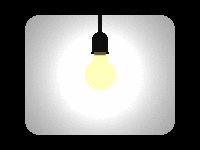Physical parameters
The overall characteristics of a device depend on specific parameters of its electrochromic components. Among them are the contrast ratio, the response time, the coloration efficiency, the write--erase efficiency, the cycle life, the power consumption [1].
The contrast ratio of an electrochromic display is the ratio between the intensity reflected by a reference surface (a non-shiny white plate) and the intensity diffusely reflected by the colored stage of the display, CR = R0/Rc. For a device working in transmittance, the contrast ratio is the ratio between the intensity of light going through the device when it is transparent and the intensity from the same source when it is obscured: CR = Tb/Tc. Both reflectance and transmittance coefficients R and T are measured at the wavelength corresponding to the maximum of the optical absorption band of the active molecules.
The response time is the time required by the electrochrome to switch from the colorless stage to the colorful stage or vice versa.
The coloration efficiency is an indication of the color intensity per unit charge density inserted, or de-inserted, in an electrochromic film. In reflectance, the color intensity can be identified with the contrast ratio CR, or it logarithm, obtained for a given charge density q. The coloration efficiency is the slope at origin of the color intensity curve versus q. It is expressed in cm2/C.
The write-erase efficiency gives the fraction of molecules in the color stages that can reversibly be turned colorless.
The cycle life is the number of write-erase cycles before a degradation can be seen by eye.
 |
In the opposite animation, a window is made almost opaque by switching an electrochromic layer from its bleach stage to its colorful stage. |
- "Electrochromism and electrochromic devices" P.M.S. Monk, R.J. Mortimer, and D.R. Rosseinsky (Cambridge University Press, 2007) 7-17 [ISBN 978-0-511-50806-5].